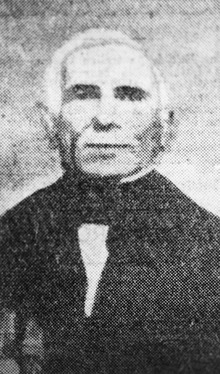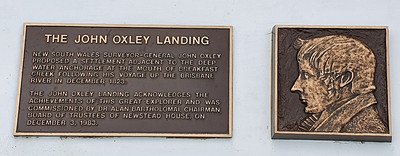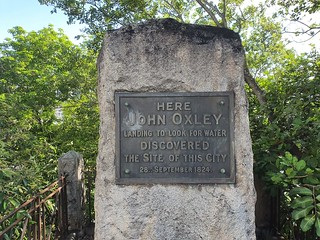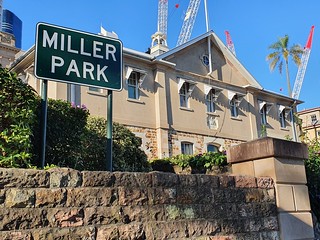The Battle of Waterloo sealed the fate of Napoleon. As a result, Great Britain was able to devote more attention to its growing colonial empire. In March 1823, the 40th Foot Regiment was ordered to go to New South Wales under the command of Lieutenant Miller (one of the heroes of Waterloo). Miller was born in 1784 in Londonderry, Ireland. The start of Australia coincided with the Napoleon era in Europe. After that was concluded in Waterloo, many of the senior officers ended up in Australia as governors, surveyors, explorer, commissariats and other in relation to our Brisbane story they include, Governor Brisbane, Surveyor John Oxley, Commanders Henry Miller and Patrick Logan.

Governor Thomas Brisbane had decided that only married officers with families were to be sent as commandants of the out-settlements, and he formally appointed Lieutenant Henry Miller to establish the Moreton Bay penal colony. Together with his family he arrived in Sydney on 16 December 1823.
As mentioned before he established the settlement in Moreton Bay but decided a few months later that this site was unsuitable. In February 1825, the decision was made to move the settlement to a site along the river.
Miller now had to find the right spot for a new site and together with Port Jackson pilot John Grey, he explored the river area in more detail.
Oxley had suggested the site next to Breakfast Creek area and this suggestion was conformed by Governor Brisbane. Miller however, selected the triangle of land bounded on two sides by the Brisbane River and the escarpment which is now Wickham Terrace. Over time a fence was built from what is now North Quay over Spring Hill (Boundary Street) to Petrie’s Bight, clearly establishing a demarcation line. Over time this also became the boundary that Aboriginal people were not allowed to cross at certain times, vagabonds and homeless people were send outside these boundaries. Later the earliest settlers stayed within these boundaries (only for a short period).
As a military man Miller saw the military potential of the site. He came just out of the war and there were still ongoing international conflicts, the perceived threats at that time could come from France and Russia. After the resistance of the Aboriginal people at Moreton Bay he also most certainly had this threat in mind.
Miller considered the area to be defensible again potential international threats. It also provided a natural barrier against potential escapes from the convict population. Defences were also established at Amity Point and Dunwich on Stradbroke Island, guarding the entrance of the river. The meandering river was also seen as strategic important from a defence point of view. The various convict, military and administrative buildings were consequently also built with security, surveillance and defensibility in mind. Another consideration can have been the fact that there is no fresh water at Breakfast Creek, while Wheat Creek at the spot he selected did provide fresh water.
He realised the potential of flooding and laid out the city, using the ridges in the landscape. This is still visible in the CBD. The convict compound along what is now Queen Street and the ridge running parallel with river, along what is now William Street are good examples. However, what he most probably had not foreseen was the fact that the tropical rain storms would create havoc and that the creeks and the ponds in the settlement would rapidly inundate areas beyond the ridges.
In May 1825 Miller relocated the increased population of 75 convicts along with officials and military to the Brisbane River site. While now on the river the site was still called the Moreton Bay Convict Settlement and Penal Colony.
Sadly, Henry Miller had a very short term. When Thomas Brisbane heard that he had not followed Oxley’s orders to establish the settlement at Breakfast Creek, he called him back to Sydney.
While it is not certain if this was part of the reason for this rebuke or even if this was considered at that time, the reality is that sailing over a meandering river is not easy especially as there is often not enough wind. A problem that later was also encountered after they built a windmill in the settlement.
In August 1825 he was replaced by Captain Peter Bishop who arrive in the Lalla Rookh with a detachment of troops and 28 convicts, all 2nd offenders while in the colony Bishop became the second Commandant of the penal colony.

Ironically, some of the political factions Thomas Brisbane had to work with in Sydney were unhappy with the governor. Malicious and vicious representations regarding Brisbane’s administration were made to the government in London. This group of people included Frederick Goulburn, the colonial secretary, who very actively boycotted orders from Brisbane. Consequently Brisbane – like his predecessor Lachlan Macquarie under similar circumstances – was called back early to Britain and left Sydney in November 1825.
Later consensus vindicates Miller’s choice for the settlement as the Queens Wharf – Roma Street site is much better suited than Breakfast Creek.

There is no indication that Oxley landed at the site mentioned in the picture above. So, if anybody climbed the embankment at North Quay where this obelisk is, it was not Oxley, but it could have been Grey and Miller.
From Sydney, Henry Miller went to Van Diemen’s Land. On 30 December 1840, his wife died in Hobart, aged 53, and on 23 August 1842 Captain Miller married again to Miss McQueen, of New Norfolk. He died at Hobart on 10 January 1866. His second wife died in 1891 and is buried at Hobart with her son, Ernest George Miller, who died in 1887, aged 37 years. Captain Miller’s grave at Hobart in course of time fell into disrepair.
As far as I know the only place in Brisbane that has preserved his name is Miller Park next to the Commissariat in Williams Street. According to information from the The Royal Historical Society of Queensland throughout its history the site has been a grassy thoroughfare between William Street and Queen’s Wharf Road, however from the 1850s onward it also provided access to the Commissariat Store’s middle floor through a doorway cut through the western wall. This was to avoid access to the ground floor of the building which continued to be used as a store. During its renovation most of a wall which predated 1838 was replaced although one section of the original wall was left adjacent to the former State Library driveway next door.

An interesting anecdote
After Henry Miller had established the Moreton Bay Penal Settlement Governor Brisbane asked his friend NSW Chief Justice Francis William Forbes to suggest a name for the place. Forbes was appointed in 1822 to be the first Chief Justice of the Supreme Court of New South Wales, following the inquiry into the colony’s affairs by commissioner John Bigge. He arrived in Sydney two years later.
Forbes chose Edinglassie after his ancestral estate near Aberdeen in Scotland a name derived from old Scottish “Eudan-glasaich” which means “hill face of the pasture” or “leyland” (fallow land). Popular culture mistakenly has it that the name was derived from the combination of Edinburgh and Glasgow.
In Brisbane however the name never really caught on. They preferred to derive the name of their town from the river and called it Brisbane.
The name Edenglassie however did survive. In the early 1830s, Forbes established the at that time only estate west of the Nepean River, at Emu Plains. There is still a retirement village with that name in this town and a thoroughbred horse stud with that name in Muswellbrook.
Source: Edinglassie (Glass, B., Tarland, det. 3). Eudan glasaich, “hill-face of the pasture or ley-land.” 180 THE PLACE NAMES Eglish Kian na Dallach (Braemar).
Take 2 The Moreton Bay Convict Settlement and Penal Colony on the river